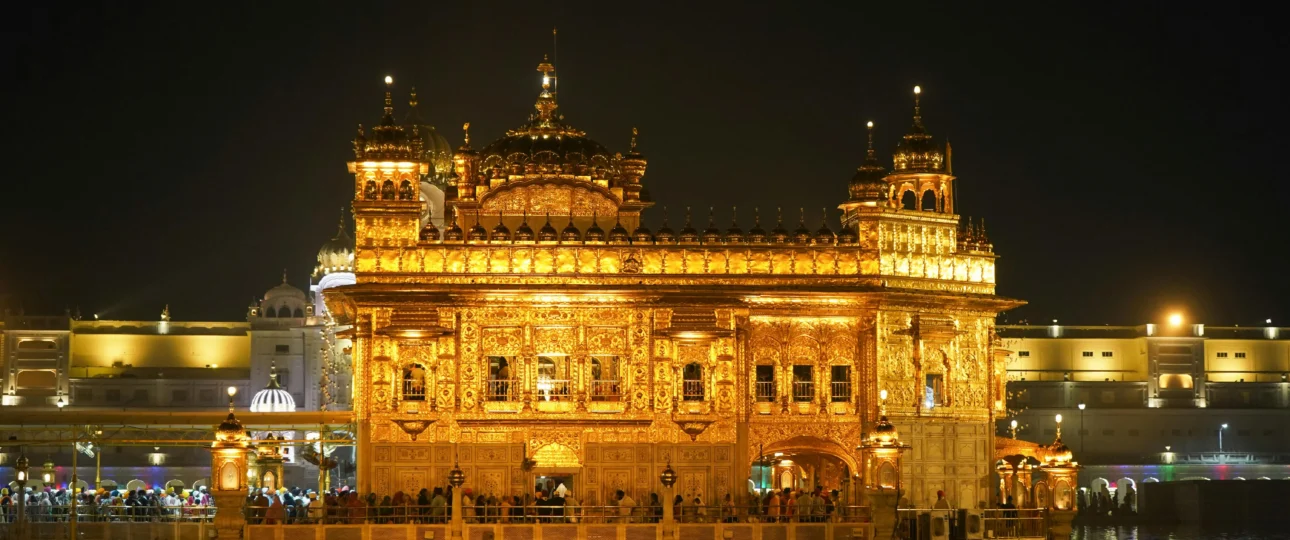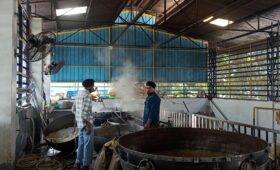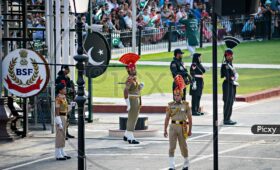Amritsar, a city in Punjab, India, is a treasure chest of history, culture, and spirituality. Known for the magnificent Golden Temple, delicious food, and warm-hearted people, Amritsar has so much more to offer. One of the best ways to explore this vibrant city is through an Amritsar Heritage Walking Tour. This tour takes you deep into the heart of Amritsar, where every street, building, and monument tells a story of the past. Whether you’re a history lover, a foodie, or just a curious traveler, this walking tour will leave you with memories to cherish.
In this article, we’ll guide you through an amazing Amritsar Heritage Walking Tour. We’ll cover the must-visit places, hidden gems, local food stops, and tips to make your trip unforgettable. By the end, you’ll know why this tour is one of the top things to do in Amritsar and how it can help you connect with the city’s rich heritage. Let’s lace up our shoes and start walking!
Walking through Amritsar is like stepping into a living history book. The city was founded in 1577 by Guru Ram Das, the fourth Sikh Guru, and has grown into a blend of old traditions and modern life. A heritage walking tour lets you see, hear, and feel the city up close. Unlike a car or bus tour, walking allows you to slow down and notice the small details—ornate windows, busy markets, and the sound of temple bells.
The Amritsar Heritage Walking Tour is perfect for: History buffs who want to learn about Sikh heritage and colonial times.
Food lovers eager to taste Amritsar’s famous dishes like Amritsari kulcha and lassi.
Photographers looking for colorful streets and stunning architecture.
Travelers who love authentic, local experiences.
This tour isn’t just about sightseeing—it’s about understanding Amritsar’s soul. From the spiritual Golden Temple to the tragic Jallianwala Bagh, every stop has a story waiting to be discovered.
Starting Point: The Golden Temple
No Amritsar Heritage Walking Tour can begin anywhere else but the Golden Temple, also known as Sri Harmandir Sahib. This is the holiest place for Sikhs and the heart of Amritsar. As you approach the temple, you’ll see its golden dome shining under the sun, surrounded by the calm waters of the Amrit Sarovar (holy pool).
What to See at the Golden Temple
The Golden Dome: Covered in real gold, it’s a sight that takes your breath away.
Amrit Sarovar: The pool where pilgrims take a dip for blessings.
The Guru Granth Sahib: The Sikh holy book, placed inside the temple, where prayers are sung day and night.
Langar Hall: A free community kitchen serving food to thousands daily.
Remove your shoes and cover your head (scarves are provided).
Walk around the Parikrama (pathway) surrounding the pool.
Sit quietly and listen to the soothing kirtan (devotional songs).
Join the langar to eat simple, delicious food with others.
The Golden Temple isn’t just a building—it’s a symbol of equality and peace. Everyone, no matter their religion or background, is welcome here. Spending an hour or two at this sacred spot sets the tone for your heritage tour.
Next Stop: Jallianwala Bagh
A short walk from the Golden Temple brings you to Jallianwala Bagh, a place that holds a painful yet important part of India’s history. On April 13, 1919, British troops fired on a peaceful crowd here, killing hundreds of innocent people. Today, it’s a memorial to honor those who lost their lives.
The Martyrs’ Well: Many jumped into this well to escape the bullets.
Bullet Marks: Still visible on the walls, a reminder of the tragedy.
Memorial Monument: A tall structure in the center of the garden.
Why It Matters
Jallianwala Bagh is a must-visit on the Amritsar Heritage Walking Tour because it shows the struggle for India’s freedom. It’s a quiet, emotional place where you can reflect on the past. Take 30-45 minutes to walk through the garden and read the signs that explain what happened.
Exploring the Old City: Narrow Lanes and Hidden Gems
After Jallianwala Bagh, your walking tour dives into the old city of Amritsar. The narrow lanes here are full of life, with colorful shops, old houses, and the smell of street food in the air. This is where you’ll see the real Amritsar—busy, chaotic, and beautiful.
Highlights of the Old City
Heritage Buildings: Look for havelis (traditional homes) with carved wooden doors and jharokhas (small balconies).
Bazaars: Markets like Guru Bazaar and Katra Jaimal Singh sell jewelry, clothes, and souvenirs.
Street Food: Stop for a quick bite—try papdi chaat or jalebi.
Walking through these lanes feels like time travel. The buildings are old, some over 100 years, and the people are friendly, often happy to chat. Keep your camera ready—the colors and energy here are perfect for photos.
The Town Hall and Partition Museum
Next, head to the Town Hall, a colonial-era building that’s now home to the Partition Museum. This museum tells the story of India’s partition in 1947, when India and Pakistan became two countries. Amritsar, being close to the border, was deeply affected.
Photos and Documents: Real images and letters from 1947.
Personal Stories: Accounts from people who lived through the partition.
Artifacts: Clothes, trunks, and items refugees carried.
The Partition Museum adds depth to your Amritsar Heritage Walking Tour. It’s a chance to learn about a major event that shaped the city and its people. Spend about an hour here to soak in the history.
Gobindgarh Fort: A Glimpse of Royalty
A little outside the old city, but worth the walk (or a short rickshaw ride), is Gobindgarh Fort. Built in the 18th century by Gujjar Singh Bhangi, a local chieftain, this fort later became a key military spot under Maharaja Ranjit Singh, the founder of the Sikh Empire.
Toshakhana: A museum with coins, weapons, and royal items.
Sher-e-Punjab Show: A light-and-sound show about Maharaja Ranjit Singh’s life.
Fort Walls: Massive and strong, showing the power of the past.
The fort is a fun stop on the tour. It mixes history with entertainment, and the evening show is a highlight. Plan to spend 1-2 hours here.
Taste Amritsar’s Flavors
By now, you’re probably hungry! Amritsar is a food lover’s paradise, and no Amritsar Heritage Walking Tour is complete without trying local dishes. Here are some stops to refuel:
Kesar Da Dhaba
Location: Near the old city.
Must-Try: Dal makhani, paratha, and phirni (a sweet dessert).
Why Go: This 100-year-old dhaba serves authentic Punjabi food in a simple setting.
Bharawan Da Dhaba
Location: Near Town Hall.
Must-Try: Amritsari kulcha with chole (chickpeas).
Why Go: Famous for its crispy, stuffed kulchas.
Guru Ka Langar (Golden Temple)
Location: Inside the Golden Temple.
Must-Try: Dal, roti, and kheer.
Why Go: Free, tasty, and a unique experience of community eating.
Take your time to enjoy the food—it’s a big part of Amritsar’s heritage. A meal break can last 30 minutes to an hour, depending on how much you want to eat!
Durgiana TempleAfter lunch, walk to the Durgiana Temple, often called the “Silver Temple” because of its silver doors. Built in 1921, it looks a lot like the Golden Temple but is dedicated to Goddess Durga.
The Main Shrine: A peaceful spot with idols of Durga, Vishnu, and Lakshmi.
The Sarovar: A holy tank similar to the Golden Temple’s.
Architecture: Beautiful carvings and a calm vibe.
This temple shows Amritsar’s mix of Sikh and Hindu cultures. It’s less crowded than the Golden Temple, so you can relax here for 30-45 minutes.
Ram Bagh: The Summer Palace
Your next stop is Ram Bagh, a garden built by Maharaja Ranjit Singh as his summer retreat. Today, it’s a public park with a small museum called the Maharaja Ranjit Singh Museum.
The Palace: A red-brick building with old photos and weapons.
Gardens: Green lawns perfect for a rest.
Statue: A big statue of Maharaja Ranjit Singh on horseback.
Ram Bagh is a quiet break from the busy streets. It’s a great spot to learn more about the Sikh Empire and unwind for an hour.
The Border Experience: Wagah Border (Optional)
If you have energy left, end your day with a trip to the Wagah Border, about 28 kilometers from Amritsar. This isn’t part of the walking tour, but many guides include it as an optional add-on with transport. Every evening, Indian and Pakistani soldiers perform a flag-lowering ceremony here.
Parade: Soldiers march with high energy and loud cheers.
Crowd: A lively atmosphere with patriotic songs.
Timing: Starts around 5:15 PM (check seasonal times).
The ceremony lasts about 45 minutes and is a thrilling way to wrap up your heritage day. You’ll need to leave Amritsar by 4 PM to reach on time.
Tips for Your Amritsar Heritage Walking Tour
To make your tour smooth and fun, here are some handy tips:
Wear Comfortable Shoes: You’ll walk 5-7 kilometers, so comfort is key.
Start Early: Begin at 7-8 AM to avoid heat and crowds.
Carry Water: Stay hydrated, especially in summer.
Dress Modestly: Cover shoulders and knees, especially at religious sites.
Hire a Guide: A local guide can share stories and history you might miss.
Plan for 6-8 Hours: The full tour, including breaks, takes most of the day.
The Amritsar Heritage Walking Tour isn’t just a list of places—it’s a journey through time. You’ll see how spirituality, bravery, and culture have shaped this city. From the Golden Temple’s serenity to Jallianwala Bagh’s somber lessons, every step connects you to Amritsar’s past and present.
An Amritsar Heritage Walking Tour is one of the best ways to experience this incredible city. It’s affordable, immersive, and full of surprises. Whether you’re gazing at the Golden Temple, tasting a hot kulcha, or standing at the Wagah Border, you’ll feel the heartbeat of Amritsar.
So, next time you’re planning a trip, add this walking tour to your list. It’s not just a walk—it’s a story of faith, freedom, and flavor. Book your trip, pack your curiosity, and get ready to fall in love with Amritsar!
Write to book Amritsar tour- balwindertourguide222@gmail.com




Interesting perspective on Amritsar! It truly sounds like a city where history and modernity coexist in harmony. I’ve always wondered how the city manages to preserve its traditions amidst rapid development. The idea of a walking tour is brilliant—it’s the best way to soak in the essence of a place. I’d love to know more about the specific spots that stand out during such a tour. Do you think the modern lifestyle is starting to overshadow the city’s historical roots? Also, how can one truly connect with the spiritual energy of Amritsar beyond just visiting the Golden Temple? I’d love to hear your thoughts!
Amritsar truly sounds like a city that breathes history and spirituality. The idea of walking through its streets, absorbing the intricate details, feels like a journey through time. It’s fascinating how Guru Ram Das’s vision has shaped a place that still resonates with such cultural and spiritual significance. The blend of tradition and modernity must create a unique atmosphere that’s hard to find elsewhere. I wonder, what’s the most striking detail you’ve noticed during such a walking tour? The mention of temple bells and bustling markets makes me curious about the sensory experience—what does it feel like to be immersed in that environment? Do you think the essence of Amritsar can truly be captured without walking its streets?
Amritsar truly sounds like a city that breathes history and spirituality. Walking through its streets must feel like a journey through time, where every corner tells a story. The blend of old traditions with modern life is fascinating—how do the locals balance these two worlds? I’d love to know more about the specific details you noticed during the walking tour, like the ornate windows or the sounds of the temple bells. The Sikh Gurus’ teachings of equality and compassion seem to resonate deeply in the city’s atmosphere. Do you think Amritsar’s essence has changed over the years, or does it still hold onto its roots strongly? I’m curious, what was the most memorable moment of your visit that made you feel connected to its history?
Amritsar seems like a city where every corner tells a story. The blend of history and modernity must create such a unique atmosphere. I can almost imagine the sound of temple bells echoing through the streets. Walking tours really do offer a more intimate way to connect with a place—details like ornate windows and bustling markets would probably go unnoticed otherwise. What’s the most surprising or memorable detail you’ve encountered during such a tour? I’d love to hear more about how the city’s traditions continue to thrive in today’s world. Do you think the essence of Amritsar’s history is well-preserved amidst its modern growth?
Walking through Amritsar sounds like a truly immersive experience! I love how the city seamlessly blends its rich history with modern life—such a unique charm. A walking tour seems like the perfect way to truly absorb the essence of the place, something you’d miss in a car or bus. The mention of ornate windows, bustling markets, and temple bells paints such a vivid picture—it’s almost like you can feel the city’s heartbeat. I’m curious, though, how does the heritage walking tour ensure that visitors really connect with the Sikh Gurus’ teachings and legacy? Do they incorporate stories or teachings during the tour? It’s fascinating to think about how a city founded by Guru Ram Das continues to thrive and inspire today. Would you say Amritsar’s essence still reflects the principles of equality and compassion that the Sikh Gurus stood for? I’d love to hear more about your thoughts on this!
Amritsar truly sounds like a city where history and modernity coexist beautifully. The idea of a heritage walking tour is fascinating—it’s amazing how slowing down can reveal so much about a place. The mention of ornate windows and temple bells makes me imagine the city’s vibrant atmosphere. I wonder if the walking tours include visits to the Golden Temple, as it seems like a must-see. How do the locals feel about the blend of tradition and modern life in Amritsar? It’s inspiring to think about how Guru Ram Das’s vision has shaped the city over centuries. Do you think the walking tours capture the essence of the Sikh Gurus’ teachings? I’d love to hear more about the personal experiences of those who’ve taken the tour.
Walking through Amritsar truly sounds like an immersive experience that connects you deeply with its rich history and culture. The idea of a heritage walking tour is brilliant—it allows you to absorb the essence of the city in a way that no vehicle ever could. The mention of ornate windows, bustling markets, and temple bells paints such a vivid picture of the sensory journey one might take. It’s fascinating how the city, founded by Guru Ram Das, continues to honor its roots while embracing modernity. I wonder, though, how the locals feel about the balance between preserving tradition and adapting to contemporary life? Do they see it as a challenge or an opportunity? Also, are there any specific spots on the walking tour that you’d say are absolute must-sees? I’d love to hear more about the personal stories or hidden gems that make Amritsar so unique. What’s your favorite part of the city, and why?
Walking through Amritsar truly sounds like an immersive experience. The blend of history and modernity must be fascinating to witness firsthand. I’ve always been curious about how the city manages to preserve its traditions while embracing contemporary life. The idea of a heritage walking tour is brilliant—it’s the small details that often tell the most compelling stories. I wonder, though, how accessible these tours are for visitors who might not be familiar with Sikh culture or history. Do you think the city does enough to educate and engage tourists about its spiritual and historical significance? I’d love to hear more about your thoughts on this!
**Walking through Amritsar** is like stepping into a living history book. The city was founded in 1577 by Guru Ram Das, the fourth Sikh Guru, and has grown into a blend of old traditions and modern life. A heritage walking tour lets you see, hear, and feel the city up close. Unlike a car or bus tour, walking allows you to slow down and notice the small details—ornate windows, busy markets, and the sound of temple bells.
**Introduction:** The Sikh Gurus hold a sacred place in the hearts of millions, revered for their profound wisdom, selfless service, and unwavering devotion to the principles of equality, justice, and compassion. As we delve into the history and teachings of these spiritual luminaries, let us honor their contributions to society.
Amritsar sounds like a fascinating city with such a rich history and vibrant culture! Walking through its streets must feel like journeying through time, especially with the blend of ancient traditions and modern life. I’m curious, what are some of the most striking details you noticed during the heritage walking tour? The mention of ornate windows and temple bells makes me imagine how visually and acoustically immersive the experience must be. Do you think slowing down and walking really enhances the connection to the city’s history, compared to a car or bus tour? I’d love to know more about how the city preserves its heritage while adapting to modern times. What’s one thing about Amritsar that surprised or inspired you the most?